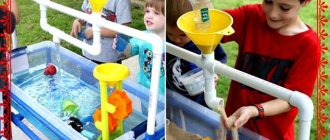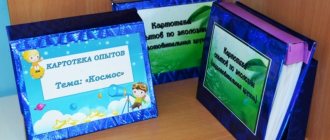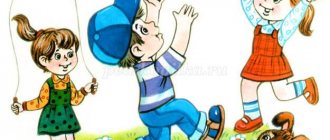Card index of didactic games on life safety (middle age)
Natalia Pustovalova
Card index of didactic games on life safety (middle age)
CARD INDEX
DIDACTIC GAMES ON
life safety fundamentals
(AVERAGE AGE)
DIDACTIC GAMES AS A MEANS OF AWARENESS AND Educating CHILDREN WITH RULES
SAFETY AT HOME.
In order to make the child active in acquiring knowledge, it is proposed to accumulate, deepen and systematize it mainly through didactic games .
The advantage of using didactic games , compared to classes to enrich knowledge about life safety rules as a component of life safety, is manifested in the following: every child is as active as possible; it is possible to differentiate and systematize children’s knowledge (depending on their current level, since the games were held with a sub-group (from 2 to 8 people)
or individually; maintaining a stable interest of preschoolers in this activity and a high emotional background.
Selected didactic games provide the opportunity to: introduce children to sources of danger in everyday life, clarify and systematize these ideas, teach them to distinguish potentially dangerous objects; form ideas about precautionary measures, about methods of safe behavior; introduce the necessary actions in case of danger.
At the same time, attention is actively developed so that the child can anticipate threats and take care of his life and health. The use of game attributes, visual aids (plot and subject pictures , incentive prizes) evokes the desire of preschoolers to play and activates their mental processes. A positive assessment from the game character and adults allows the child to affirm the correct understanding of the norms of safe behavior.
“PICK UP A TOY FOR TANYUSHKA”
Objectives: to consolidate ideas about household objects that can/cannot be played with; develop attention; cultivate a sense of mutual assistance.
Material:
— a game card with a picture of a girl and “fun”
little men;
- pictures depicting various household items and toys.
Progress of the game: the teacher offers to help Tanya choose from the objects shown by the cheerful people those that can be played with; explain why you can't play with the others.
“ONE, TWO, THREE, WHAT COULD BE DANGEROUS - FIND IT”
Objectives: to consolidate ideas about the sources of danger in the house; develop intelligence and attention; foster a sense of camaraderie.
Rule: do not push, do not take objects from each other.
Material: layout or game corner with household items, prizes (chips or pictures )
.
Progress of the game. The teacher, or Stobed, or the child turns away and counts to 3-5 (if necessary, up to 10, and during this time the children should take from the model or in the play corner those objects that, in their opinion, may be dangerous. Then each explains his choice. Answers are rewarded with prizes.
“WHAT DO WE KNOW ABOUT THINGS?”
Objectives: expand children’s understanding of the rules of safe behavior at home; develop attention and memory; cultivate a sense of cooperation.
Material:
* four game cards depicting a cut, burn, hand injury and fire;
* pictures depicting various household items.
Progress of the game. 4 children take part in the game, each of them takes a game card with the image of an “injury”
.
The teacher (hereinafter referred to as the child)
is the leader.
a picture of an object one by one Participants must guess what kind of injury could result from improper handling of this item, match it to their card and take the picture .
When selecting, the child must explain why this or that object is dangerous and tell the rules for handling it. "SNAIL HOUSE"
Objectives: generalize children’s ideas about the rules of safe behavior; develop protective self-awareness; foster a sense of cooperation and strengthen numeracy skills.
Rule: follow the order.
Material: playing field with the image of a snail, inside the house of which various household items are drawn; chips; cube.
Progress of the game. Children take turns throwing the dice and moving their piece by as many spaces as there are dots on the dice. Each player talks about the picture on which his chip stands: what is depicted, the rules for handling this item.
"CONNECT THE DOTS"
Objectives: to consolidate ideas about sources of danger in everyday life; develop fine motor skills, strengthen the skills of using a pencil, the ability to draw a line along the dots; develop the ability to complete a task that has been started.
Material: sheets depicting the outlines of objects (from to-chek)
.
Assignment: connect the dots, color and tell why this object is dangerous.
"PUT IT IN PLACE"
Objectives: to consolidate ideas about the rules of safe behavior, to develop knowledge that to be safe, all objects must be put back in their place; develop observation and attention; cultivate a desire to maintain cleanliness and order at home and in kindergarten.
Material: playing field with a picture of a kitchen; pictures-objects .
Progress of the game. The box contains pictures of objects (image down)
.
Each child takes one picture and puts it on the playing field - in place, explaining his choice.
Options.
*
Pictures-objects are “scattered” .
Children take turns putting them in place. * On the layout, put all the items in their places, first in the “kitchen”
, and then throughout
the “apartment”
.
* The same in the play corner.
“SO AND NOT SO”
Objectives: to teach to distinguish life-threatening situations from non-dangerous ones; develop attention; cultivate a desire to comply with safety rules.
Material:
* 2 cards - with a red and a green circle,
* pictures depicting dangerous and safe actions of children.
Rules: under a red card (circle)
put
pictures depicting life-threatening actions of the child, under the green - non-hazardous (allowed) ones
.
Options:
* individually with the teacher,
* several children take turns explaining their choice.
Approximate content of the pictures : a child sits, reads, watches TV, plays with matches, stands on the windowsill, vacuums, plugs in the TV, takes a toy from the top shelf of the closet, runs on a wet floor, plays on the balcony, etc. all types of dangerous situations.
Option: “POSSIBLE - CAN’T”
(using photographs of children)
.
Unlike pictures , the use of photographs makes it possible to show the child a real dangerous everyday situation, to draw the preschooler’s attention to details, to consolidate knowledge about sources of danger, methods of safe behavior and safety precautions. In addition, this technique acts as a kind of “bridge”
from knowledge to the formation of skills: the child, examining and analyzing (
“speaking out”
) the depicted situation, becomes established in the norms
(rules)
of safe behavior.
To do this, you can ask some parents to photograph their child in various home situations that are close to dangerous (for example, looking into the oven, cutting bread, standing on the windowsill, playing with toys, playing with a hammer and forks, etc.) . The resulting manual “Dos and Don’ts”
will be looked at and discussed with pleasure by children
(even without the participation of adults)
.
"ONE HUNDRED TROUBLES"
Objectives: to consolidate ideas about dangerous situations that can happen at home, to teach the rules of safe behavior in everyday life; develop memory, attention; cultivate a sympathetic attitude towards the victim.
Material:
pictures of children in dangerous situations at home.
Progress of the game: several pictures lie on the table face down. The child chooses any one, examines it and tells: what is depicted on it, why this happened to the child, what he did wrong, what should the child do now.
“I’M NOT AFRAID OF NEEDLES”
Objectives: strengthen the ability to safely handle a needle; develop fine motor skills; cultivate attention and perseverance.
Material: needles and threads attached to the base of the box; buttons.
Tasks: assemble a “pyramid”
from buttons, stringing them on a needle and thread;
assemble the “beads”
by threading a needle and thread through both holes of the buttons.
"WE ARE THE RESCUE"
Objectives: to consolidate ideas about dangerous situations in everyday life, about the correct actions in specific situations; develop attention; cultivate a sympathetic attitude towards the victim.
Material:
* game map with three empty windows (one at the top, two at the bottom)
;
* pictures depicting children in specific dangerous situations;
* a set of cards depicting the actions that need to be performed in a given situation.
Progress of the game. The teacher places a picture depicting a dangerous situation on the game The child examines it and, from all the cards depicting actions, selects the two correct ones and lays them out sequentially.
"CONNECT THE DOTS"
Objectives: to consolidate ideas about the sources of danger in everyday life; develop fine motor skills, strengthen the skills of using a pencil, the ability to draw a line along the dots; develop the ability to complete a task that has been started.
Material: sheets depicting the outlines of objects (from dots)
.
Assignment: connect the dots, color and tell why this object is dangerous.
“WHAT DO WE KNOW ABOUT THINGS?” (lotto)
Objectives: expand children’s understanding of the rules of safe behavior at home; develop attention and memory; cultivate a sense of cooperation.
Material: four playing cards depicting a cut, a burn, a bruised hand and a fire; pictures depicting various household items.
Progress of the game. 4 children take part in the game, each of them takes a game card with the image of an “injury”
.
The teacher (hereinafter referred to as the child)
is the leader.
He picks up a picture of an object one by one. Participants must guess what kind of injury could result from improper handling of this object, match it with their card and take the picture .
When selecting, the child must explain why this or that object is dangerous and tell the rules for handling it. "PUT IT IN PLACE"
Objectives: to consolidate ideas about the rules of safe behavior, to develop knowledge that for safety all objects must be put back in their places; develop observation and attention; cultivate a desire to maintain cleanliness and order at home and in kindergarten.
Material: playing field with a picture of a kitchen; pictures-objects .
Progress of the game. The box contains pictures-objects (image down)
.
Each child takes one picture and puts it on the playing field - in place, explaining his choice.
Options.
Pictures of objects are “scattered” on the playing field . Children take turns putting them in place. On the layout, put all the items in their places, first in the “kitchen”
, and then throughout the
“apartment”
.
* The same in the play corner.
Card index of games on life safety
MBDOU - kindergarten No. 7
in the middle group
Prepared by: Oshchepkova Ya.I.
Educator.
Ekaterinburg, 2022
Explanatory note
In order to make the child active in acquiring knowledge, it is proposed to accumulate, deepen and systematize it mainly through didactic games .
The advantage of using didactic games ,
in comparison with classes to enrich knowledge about life safety rules as a component of safety precautions in everyday life, it is manifested in the following: each child is as active as possible;
there is an opportunity to differentiate and systematize children’s knowledge (depending on their current level, since the games were held with a subgroup (from 2 to 8 people)
or individually; maintaining preschoolers’ sustainable interest in this activity and a high emotional background.
Selected didactic games provide the opportunity to: introduce children to sources of danger in everyday life, clarify and systematize these ideas, teach them to distinguish potentially dangerous objects; form ideas about precautionary measures and methods of safe behavior; introduce the necessary actions in case of danger.
At the same time, attention is actively developed so that the child can anticipate threats and take care of his life and health. The use of game attributes, visual aids (plot and subject pictures ,
Incentive prizes make preschoolers want to play and activate their mental processes. A positive assessment from the game character and adults allows the child to confirm his correct understanding of the norms of safe behavior.
“PICK UP A TOY FOR TANYUSHKA”
Objectives: to consolidate ideas about household objects that can/cannot be played with; develop attention; cultivate a sense of mutual assistance.
Material:
— a game card with a picture of a girl and “fun”
little men;
- pictures depicting various household items and toys.
Progress of the game: the teacher offers to help Tanya choose from the objects shown by the cheerful people those that can be played with; explain why you can't play with the others.
“ONE, TWO, THREE, WHAT COULD BE DANGEROUS - FIND IT”
Objectives: to consolidate ideas about the sources of danger in the house; develop intelligence and attention; foster a sense of camaraderie.
Rule: do not push, do not take objects from each other.
Material: layout or game corner with household items, prizes (chips or pictures )
.
Progress of the game. The teacher, or Stobed, or the child turns away and counts to 3-5 (if necessary, up to 10, and during this time the children should take from the model or in the play corner those objects that, in their opinion, may be dangerous. Then each explains his choice. Answers are rewarded with prizes.
“WHAT DO WE KNOW ABOUT THINGS?”
Objectives: expand children’s understanding of the rules of safe behavior at home; develop attention and memory; cultivate a sense of cooperation.
Material:
* four game cards depicting a cut, burn, hand injury and fire;
* pictures depicting various household items.
Progress of the game. 4 children take part in the game, each of them takes a game card with the image of an “injury”
.
The teacher (hereinafter referred to as the child)
is the leader.
He picks up a picture of an object one by one. Participants must guess what injury could result from improper handling of this item, match it to their card and take the picture .
When selecting, the child must explain why this or that object is dangerous and tell the rules for handling it. "SNAIL HOUSE"
Objectives: generalize children’s ideas about the rules of safe behavior; develop protective self-awareness; foster a sense of cooperation and strengthen numeracy skills.
Rule: follow the order.
Material: playing field with a picture of a snail, inside the house of which various household items are drawn; chips; cube.
Progress of the game. Children take turns throwing the dice and moving their piece by as many spaces as there are dots on the dice. Each player talks about the picture ,
on which its chip stands: what is depicted, the rules for handling this item.
"CONNECT THE DOTS"
Objectives: to consolidate ideas about sources of danger in everyday life; develop fine motor skills, strengthen the skills of using a pencil, the ability to draw a line along the dots; develop the ability to complete a task that has been started.
Material: sheets depicting the outlines of objects (from dots)
.
Assignment: connect the dots, color and tell why this object is dangerous.
"PUT IT IN PLACE"
Objectives: to consolidate ideas about the rules of safe behavior, to develop knowledge that for safety all objects must be put back in their places; develop observation and attention; cultivate a desire to maintain cleanliness and order at home and in kindergarten.
Material: playing field with a picture of a kitchen; pictures-objects .
Progress of the game. The box contains pictures of objects (image down)
.
Each child takes one picture and puts it on the playing field - in place, explaining his choice.
Options.
*
Pictures-objects are “scattered” .
Children take turns putting them in place.
* On the layout, put all the items in their places, first in the “kitchen”
, and then throughout
the “apartment”
.
* The same in the play corner.
“SO AND NOT SO”
Objectives: to teach to distinguish life-threatening situations from non-dangerous ones; develop attention; cultivate a desire to comply with safety rules.
Material:
* 2 cards - with a red and a green circle,
* pictures depicting dangerous and safe actions of children.
Rules: under a red card (circle)
put
pictures depicting life-threatening actions of the child, under the green - non-hazardous (allowed) ones
.
Options:
* individually with the teacher,
* several children take turns explaining their choice.
Approximate content of pictures :
the child sits, reads, watches TV, plays with matches, stands on the windowsill, vacuums, plugs in the TV, takes a toy from the top shelf of the closet, runs on a wet floor, plays on the balcony, etc. for all types of dangerous situations .
Option: “POSSIBLE - CAN’T”
(using photographs of children)
.
Unlike the pictures ,
the use of photographs makes it possible to show the child a real dangerous everyday situation, to draw the preschooler’s attention to details, to consolidate knowledge about sources of danger, methods of safe behavior and precautions.
In addition, this technique acts as a kind of “bridge”
from knowledge to the formation of skills: the child, by examining and analyzing (
“talking out”
) the depicted situation, is confirmed in the norms
(rules)
of safe behavior.
To do this, you can ask some parents to photograph their child in various home situations that are close to dangerous (for example, looking into the oven, cutting bread, standing on the windowsill, playing with toys, playing with a hammer and forks, etc.). The resulting guide, “Do’s and Don’ts”,
will be looked at and discussed with pleasure by children
(even without the participation of adults)
.
"ONE HUNDRED TROUBLES"
Objectives: to consolidate ideas about dangerous situations that can happen at home, to teach the rules of safe behavior at home; develop memory, attention; cultivate a sympathetic attitude towards the victim.
Material: pictures depicting children in a dangerous situation at home.
Game progress: several pictures lie face down on the table. The child chooses any one, examines it and tells: what is depicted on it, why this happened to the child, what he did wrong, what should the child do now.
“I’M NOT AFRAID OF NEEDLES”
Objectives: strengthen the ability to safely handle a needle; develop fine motor skills; cultivate attention and perseverance.
Material: needles and threads attached to the base of the box; buttons.
Tasks: assemble a “pyramid”
from buttons, stringing them on a needle and thread;
assemble the “beads”
by threading a needle and thread through both button holes.
"WE ARE THE RESCUE"
Objectives: to consolidate ideas about dangerous situations in everyday life, about the correct actions in specific situations; develop attention; cultivate a sympathetic attitude towards the victim.
Material:
* game map with three empty windows (one at the top, two at the bottom)
;
* pictures depicting children in specific dangerous situations;
* a set of cards depicting the actions that need to be performed in a given situation.
Progress of the game. The teacher places a picture depicting a dangerous situation on the game The child examines it and, from all the cards depicting actions, selects the two correct ones and lays them out sequentially.
"PUT IT IN PLACE"
Objectives: to consolidate ideas about the rules of safe behavior, to develop knowledge that for safety all objects must be put back in their places; develop observation and attention; cultivate a desire to maintain cleanliness and order at home and in kindergarten.
Material: playing field with a picture of a kitchen; pictures-objects .
Progress of the game. The box contains pictures of objects (image down)
.
Each child takes one picture and puts it on the playing field - in place, explaining his choice.
Options.
Pictures of objects are “scattered” on the playing field . Children take turns putting them in place. On the layout, put all the items in their places, first in the “kitchen”
, and then throughout the
“apartment”
.
Card index of didactic games on safety in the middle group
Didactic games on safety in the middle group
"Familiar, friend, stranger"
Target:
Formation of a precise concept of who is “friend”, “stranger”, “familiar”.
Material:
Ball.
Progress of the game:
Before starting the game, find out from the children who, in their opinion, can be considered “their own” and who can be considered a “stranger”, who can be called an “acquaintance”, how an acquaintance differs from a loved one, than from a stranger, an outsider. Children stand at a short distance from each other, forming a circle. The presenter, in the center, throws the ball to everyone in turn, saying: familiar, friendly, alien, highlighting with intonation and pause the one who needs to be named. The child who catches the ball names the appropriate person and returns the ball to the leader.
"Traffic Laws"
Goals:
Strengthen the basics of road literacy; introduce the main road signs, their classification, purpose; promote the development of attention, memory, thinking.
Progress of the game:
The teacher takes on the role of a traffic police inspector. Participants move around the playing field using a cube. If the color is green - movement is allowed, yellow - attention, red - stop - the player misses a move. If the chip lands on a field with a picture of a road sign, the participant needs to find a sign from this group in the “common bank”. The one who scores the most points wins. 1 card – one point.
"Card Quiz"
Target
: To consolidate children's knowledge about fire safety rules. Develop memory, thinking, speech. Foster a sense of responsibility.
Progress of the game:
The teacher lays out on the table, or puts in a beautifully decorated box, cards with questions on the topic of rules of behavior during a fire. The child who answers the question correctly gets a chip. The one who has the most chips at the end of the game wins.
Question options:
— Name the possible cause of the fire;
- how to call the fire department correctly;
- what to do if during a fire there is no way to call the fire brigade, and the routes out of the house are cut off by the fire;
— is it possible to extinguish a fire without first calling the fire brigade;
- what to do if there is a smell of gas in the house;
— is it possible to hide in a closet or under a table during a fire;
— Is it possible to set poplar fluff on fire?
— is it possible to create a draft during a fire by opening all windows and doors at the same time;
— is it possible to use the elevator during a fire in the house;
— what needs to be saved first during a fire: money, documents or yourself;
— how to properly leave a smoky room;
— Is it possible to play with matches and lighters and why.
"Tops-Roots"
Target :
Exercise children in classifying vegetables (based on the principle: what is edible - the root or the fruit on the stem).
Game rules. You can only answer in two words: tops and roots. Whoever makes a mistake pays forfeit.
Game actions
. Playing forfeits.
Progress of the game:
The teacher clarifies with the children what they will call tops and what roots: “The edible root of a vegetable is called tops, and the edible fruit on the stem is called tops.” The teacher names a vegetable, and the children quickly answer what is edible in it: the tops or roots. The teacher warns the children to be attentive, since some vegetables contain both edibles. The teacher calls: “Carrot!” Children answer: “Roots”, “Tomato!” - “Tops.” "Onion!" - “Tops and roots.” The one who makes a mistake pays a forfeit, which is redeemed at the end of the game.
The teacher may offer another option; he says “Tops,” and the children remember vegetables whose tops are edible. This game is good to play after a conversation about vegetables and gardening.
"In a world of dangerous things"
Target:
Continue to introduce children to objects that may be dangerous to life and health, but which are necessary for humans. Warn against possible accidents at home.
Progress of the game:
The teacher demonstrates household items. Children clap when something is safe and stomp if an object could cause harm.




